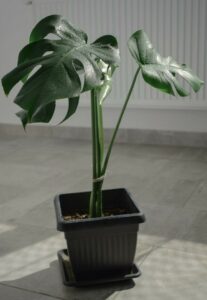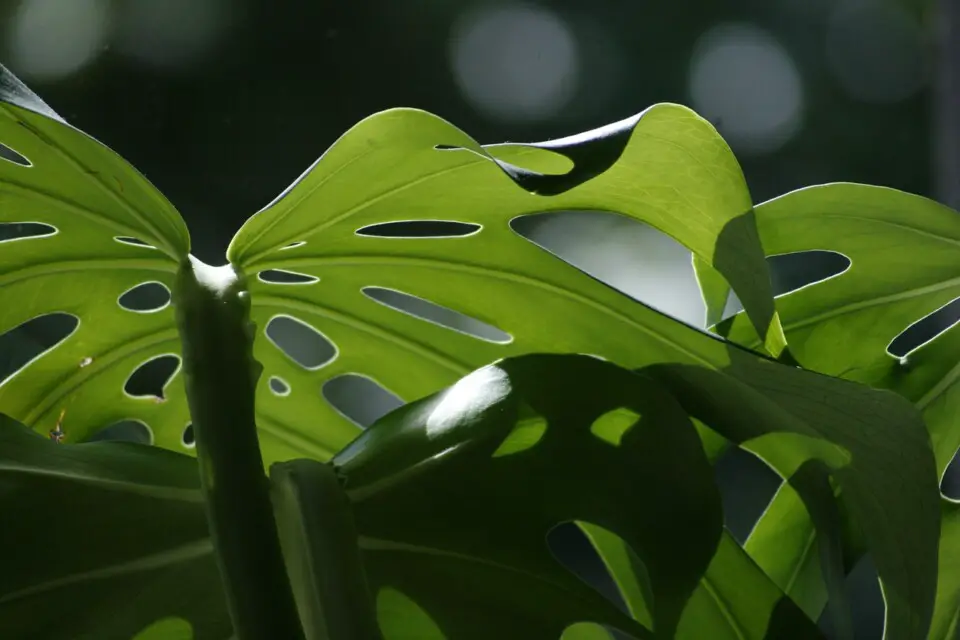Some links in the post are affiliate links and I get a commission from purchases made through some links found in the post.
It feels really annoying when one day you go to bed watching your growing green houseplants & then you wake up the nexy day with all the leaves of your favourite plant Monstera turning brown.
The brown leaves on your Monstera can be a signal of under-watering, overwatering, or a lack of sunlight.
The overwatering problem can be so much deadlier for your Monstera as this will generate different issues like root rot.
Other reasons behind your Monstera leaves turning brown can be due to low humidity, imperfect humid conditions, prolonged desiccation of soil, and diseases.
Fortunately, with different sorts of fixes, you can easily maintain the health of your Monstera.
You must rule out a few more serious culprits, like pests, and diseases, and also need to fix such kinds of problems for future safety or it doesn’t come back.
So, it is a good idea to go through this guide to determine the best possible causes of your Monstera leaves turning brown and how to fix them.
Why is Your Monstera Turning Brown?
If your monstera is turning brown, there may be a possibility that either it is due to overwatering or getting exposed to excess amounts of direct sunlight.
Other relevant reasons associated with the Monstera turning brown can be disease, humidity, and watering. Let’s have a detailed look at each reason:
1) Overwatering
 This is one of the most concerning reasons associated with the Monstera leaves turning brown.
This is one of the most concerning reasons associated with the Monstera leaves turning brown.
This problem continues to persist when the soil doesn’t absorb the water properly, eventually, this leads to the Monstera plants roots staying inside the water for too long.
Both excess water, as well as moisture, can cause the roots to rot, resulting in the plants having very dark-brown spots or black spots after a long period of time.
Overwatering your Monstera plant doesn’t develop in one or two times of watering but someone giving excess water to Monstera over time.
Few plants require soil to dry, but for the tropical plants like a Monstera, you need to be assured that the top soil dries between waterings.
Possible Fix:
If the soil, you need to skip watering for a few days because severe rot related to roots can eventually kill your Monstera plant.
Also, the excess water breaks the efficient absorption of nutrients and moisture and makes the plants weak.
2) Under-Watering
Monstera which is a tropical plant, will not grow properly in dry soil and lack of water adversely affects the absorption of the nutrients.
In case you find your Monstera growing light-brown patches or crispy edges on leaves, then there is a possibility that you are under-watering it.
Possible Fix:
While this is a good idea to first let the soil dry completely before watering so that you can avoid water-flooding, one need not wait until it becomes entirely parched.
One of the best ways to figure out whether the soil is over-compacted or crumbling.
3) Excess sunlight
One of the major issues linked with a Monstera turning brown is the excess amount of sunlight. Your Monster plant thrives under indirect & bright sunlight.
Therefore, heavy exposure to direct sunlight may result in destroying your Monstera through sunburnt.
Possible Fix:
It is a better idea to watch out for the light needs of your Monstera as it may burn leaves that can’t be recovered.
You can easily save it from burning or turning brown by placing your plant around 3-4 feet away from the southern-facing window in order to be assured about getting the optimal amount of sunlight without any exposure to direct sunlight.
Also, you can choose a place that comes out differently in terms of orientation where light can be softer or appropriate for the Monstera. For defusing the sunlight just make use of window blinds.
During the winter season, Monstera can stand comfortably in front of direct sunlight for some hours but when it is summer then strong rays from the sun may affect your plant, so it is a good practice to change the position as per the season.
4) A Low humidity level
A tropical plant, Monstera is native to humid conditions & thrives under extreme weather conditions.
In case the leaf margin related to the plant begins turning brown with the plant dropping then probably the humid condition is not perfectly suitable in your house in terms of low moisture.
The plant may lose a huge amount of moisture from the transpiration, thus causing your Monstera to turn brown.
Possible Fix:
In order to increase the humidity level, you can make use of a pebble tray, humidifier, or grouping houseplants altogether can also be useful.
5) Disease
 Among the plants like Monstera, certain typical fungal infections are most common like eyespot disease or better known as peacock eye where the spots on the leaf may look similar to the eyes.
Among the plants like Monstera, certain typical fungal infections are most common like eyespot disease or better known as peacock eye where the spots on the leaf may look similar to the eyes.
If you are experiencing yellow rings/halos around brown spots of Anthracnose, that is nothing but a collection of interlinked fungal diseases, and this could lead to your Monstera turning brown.
In this case, the leaves first turn yellow, and brown and then eventually kill the plant when all the leaves fall off. Wet foliage is also the main cause of this thing.
Possible Fix:
Never leave your plant wet for a long duration. Take appropriate actions in case you notice brown spots on the leaves to determine the effects.
6) Poor water quality
The quality of water people utilize in order to water the plants also matters a lot and it is crucial for the growth of Monstera if it is new.
Possible fix:
You need to test your water quality in terms of the amount of fluoride in the water as sometimes fluoride toxicity can be there in the houseplants and this can be observed with the tips of leaves turning brown.
You can use rainwater or distilled water to water the plants to help fix this.
Future Preventions to Fix your monstera browning
After determining the causes behind your Monstera leaves turning brown, a few steps that can be applied to fix these problems so that you can prevent any future occurrences:
Don’t Overwater
- It is a good idea to maintain a watering schedule but you also need to pay attention to the overall condition of the plant & soil. Always make sure to allow a top-inch or probably two of the soil to dry prior to watering the Monstera again.
- Check for the houseplant’s pot size as a too small container will not be able to solve water-related problems.
Deliver enough water
- Creating a watering routine after examining the soil will eventually solve the problem of underwatering and overwatering. Check the soil and make sure that is it not turning too dry.
- Give your Monstera a good soaking and for this, you can wait for the top 2-3 inches of soil to dry prior to watering it again.
Give sufficient fertilizers
- Your Monstera plant also requires a good amount of nutrients to grow and it doesn’t only depend on sunlight. Making a good balance of minerals will help your monstera to flourish. Also, fertilizers can provide much-needed vitamins for the plants to stay in excellent condition.
- Feeding your plants with enough nutrients will turn them attractive and full of green leaves, thus making them entirely perfect for the house or office decor.
- Lack of balanced nutrients may cause stunted growth & leaf discolouration and can be the major reason behind your Monstera turning brown.
- In order to increase healthy growth, a balanced amount of phosphorus, nitrogen, and potassium should be in the fertilizer. This can be in solid or liquid form. Adding these fertilizers while watering can give you good results.
- The best time to fertilizer your Monstera is during its active growing season. Also, a type of fertilization used with regular planning matters a lot.
Conduct routine Disease and pest checks
- Both pests & diseases can cause serious damage to your Monstera plant. Pests in your House like fungus-gnats, spiders, mealybugs, scale, aphids, or Thrips can cause major problems. They can suck the moisture right from the Monstera leaves thus leading to brown spots on your Monstera due to dehydration.
- Check the leaves regularly and thoroughly at the time of watering or cleaning. If you notice something serious in the form of infection on the stems or leaves then take appropriate treatment actions immediately.
- Also, keep your eyes open for webbing, and cottony materials, as this indicates the presence of pests.
- You can also inspect plants prior to purchasing them or you can quarantine the new plants before eventually mixing them with others to prevent further spread of diseases in your collection of plants.
- Make use of pesticides in order to remove them once & for all. You can also clean the pots to remove the fungal infection and this can be done by repotting the Monstera inside a new pot.
Check light situation
 As we have discussed earlier, the Monstera plant requires bright, indirect sunlight to grow. Giving them too much light can burn the plants leaves and probably leads to brown leaves or in extreme situation killing the plant.
As we have discussed earlier, the Monstera plant requires bright, indirect sunlight to grow. Giving them too much light can burn the plants leaves and probably leads to brown leaves or in extreme situation killing the plant.- It is a good thing to check the intensity, as well as the total duration of the light Monstera plant, is getting.
- Either move it away from your house or office window by some feet or take away your Monstera plant from the southern-facing window to another position to solve this problem.
- Alternatively, add curtains to filter sunlight thus making it more favorable to the houseplant
Provide Some Moisture
There are multiple ways to effectively manage humidity level for your plant:-
- Mist leaves of your Monstera plant on a frequent basis with clean water. It is a temporary solution.
- For the long-term benefit, you need to keep humidity levels slightly higher following Monstera’s preferences. For this, you can set up a pebble tray on the bottom of your pot. Also, protect Monstera against the air drafts from the air-conditioners or radiators by taking it away from these things.
- Make use of a humidifier to increase indoor humidity. In most cases, bathrooms & basements can have the best possible humidity levels that are suitable for the overall growth of the Monstera plant.
- Purchase a hygrometer for measuring humidity & consider having a selection of a good place for the plant.
Fight against leaf infections
Fungal or bacterial infections are difficult to manage, but they can be simply avoided. In other causes of browning having been successfully ruled out, then it is a higher possibility that your plant is facing a fungal or bacterial infection. One of the most promising solutions to manage this is to remove the affected leaves.
- To curb this, you can have new soil for the plants on a frequent basis in order to prevent the further spread of infections or diseases.
- Remove affected leaves in order to avoid further spread of disease.
- Make use of fungicides to prevent infections or keep the plants indoors or under a shade when it is hotter outside.
Should I cut off brown Monstera leaves?
A direct answer to this question is yes, you can do it, but this doesn’t mean you need to cut all the leaves, only cut off the browned tips. Doing this will let the leaf adjusts automatically in order to maintain the structure & shape.
In order to cut the Monstera plant leaves that are dying or diseased for different reasons, just make use of a sharp blade in order to cut them off at their stem.
Don’t damage the Monstera plant’s central stem where eventually the new leaves will start their formation. Preserve the healthy part by cutting off a tiny brown part.
Also, the leaves just being cut no longer takes part in the process of photosynthesis & can’t produce the required energy for the plant.
Along with this they are having no further resistance against the decay & infection compared to the healthy leaves.
So, eventually removing the brown leaves will help you to give better protection to the rest of the plant. Bacteria & fungus consume nutrients present in the decaying plant cells & proliferate on its surface.
Also, your Monstera will look better with no brown leaves.
Can Brown Monstera Leaves Recover?
Just leaving any remaining portion of green bits of leaf in a correct place, can easily benefit the Monstera as they can still supply the required food through photosynthesis.
You need to be careful enough to protect the leaves by not removing too many leaves altogether even in case of extensive damage because doing so will stop the plants process of photosynthesis and the plant will not be able to recover if you are cutting too many leaves off at once. Just cut off only those leaves that are extremely damaged or dead.
It is sad to leave the brown leaves of a Monstera behind as Brown leaves can’t be recovered further, but you can apply some principles to rectify the issues and recover the healthy leaves of your Monstera or in simple words keep it intact from further infection.
If you believe that a recent fungal/bacterial infection majorly caused damage to the Monstera leaves, then just clean the cutting instrument before & after using it with rubbing alcohol.
Damages made from the various other causes like overwatering are not infectious & can’t be spread to the healthy leaves just with a touch.
Final Thoughts
 The Monstera plant leaves turning brown is the first indication of the problem with the plant in most cases. Still, various such problems can be resolved easily with small adjustments to the plant’s daily care routine.
The Monstera plant leaves turning brown is the first indication of the problem with the plant in most cases. Still, various such problems can be resolved easily with small adjustments to the plant’s daily care routine.
The problem gets more serious when you have to deal with pests and diseases. So, keeping your eyes open on the Monstera will assure your plant of better protection.
You need to address certain issues carefully before it becomes out of control, or in the worst case further spreads to various other attractive plants in your office or house.
With some easy houseplant fixtures, you can solve many issues with no worries, thus gaining back the happiness of your growing Monstera.

